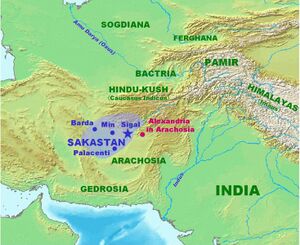Ancient Abode of Jats
| Author of this article is Dr. Raj Pal Singh |
Introduction
There is controversy on the original home of the Indo-Aryans and the same is the case with the Jats. In order to examine the views of different historians on this very significant aspect of the Jat history, we shall first take up the issue about of the original home of the people known as Indo-Aryans in a nutshell and then take up further steps to find out the ancient abode of the Jats.
Background to study
A. Language Theory needs examination: Just as molecular biologists use the presence of similar biomolecules in different species as evidence of their relatedness and can reach the originator species of the biomolecule, similarly, presence of closely related grammar, syntax, vocabulary and vocalization among known languages if worked backwards, can give important clues to their mother language, which in turn may help reveal the geographic location and its time in history. The current prevalence of Sanskrit based regional languages in India (Gujrati, Hindi, Punjabi, Bengali etc.) have led many linguists to conclude that Northern India shares a linguistic influence with regions where Indo European languages are spoken i.e., Europe, West Asia (German, Italian, English, Greek, Iranian etc).
Interestingly, some south Indian languages such as Tamil- are not considered having roots in Indo European language- indicating separate origin. History scholars have evidence based on excavated manuscripts from sites in modern Turkey together with linguistic theories to conclude that the mother language of Indo European languages originated from near Black sea and Turkey.
B. Flood Theory: This theory says that due to food surplus in this region some 6000 BC (thereby swinging the regions population beyond the carrying capacity of the region) led to the migration to people from this region to Eurasia (including North India). There are some others who promulgate the belief that last Ice Age (~10,000 BC: this number has been established by carbon dating method) turned areas in Central Asia cold deserts (scientifically established) which led to their migration to Europe (Steppes geography) and fertile South Asia- therefore lending credence to the theory that speakers of Indo European languages come from the same stock including therein Jats.
Key lies with History of Central Asia
Perhaps to solve the knot of discord on the issue of chronology of Indian History in general and and History of the Jats in particular, perhaps the history of Central Asia, covering the area of former Soviet Central Asia known in Russia as Middle Asia, the whole of Afghanistan, the northern parts of Pakistan and India, and the north-eastern part of Iran, holds the key.

Our concern is with this area where the ancient states of Bactria, Sogdiana and Khwarezm grew up. It was the birthplace of a civilisation which in its long history was closely connected with interrelated Iranian and Indian civilisations, and was influenced greatly in the last centuries of B.C. by the Hellenistic culture. Adjacent areas lying towards Indian continent were handed over to Chandragupta Maurya under a treaty signed between the Selucus Niketar in 305 B.C. Here the Kushana Empire was built up and flourished throughout a period of almost five centuries.
The region of Central Asia has witnessed the rise and spread of some of the earliest and greatest civilizations of the world. As is known well, geography is a compelling factor in history, and India is so situated as to have become inevitably the meeting point of the great movements of peoples and ideas which has taken place in Central Asia in particular and Asia in general since times immemorial. From the earliest times, that is as far back as we can go in history, the destiny of India has been closely interlinked with the development in the north and even the mighty Himalayas could not divide and isolate us from the countries beyond.
The time has come when we must think in terms of human civilisation and not merely in terms of a caste a country or region. It is necessary therefore that the much needed cooperation between countries of Central Asia which existed through the ages should be brought on the pages of history. To whichever land our ancestors may have belonged in yore and to whichever country we may belong now this must be our common mission and united effort "to achieve goodwill between man and man, to establish a secure foundation of fellowship which will save humanity from suicidal war and the savagery of fanatical superstition we must usher in the age of reason, of cooperation, of a generous reciprocity of culture which will reveal the richness of our common humanity."
Further reading on the issue:http://www.sino-platonic.org/complete/spp127_getes.pdf
Review of Existing Theories about the origin
Sources
This mission could be achieved only if we understand our common roots, the roots that lay in the central Asia of which India was also a part. So let us discover the historical process of the past ages and march forward in finding out the facts of history afresh by using the latest tools of research, the tools like archaeology, numismatics, science, genetics, anthropology and so on. The facts could be gleaned and collected only by applying multi-disciplinary approach,
External links
See also
References

